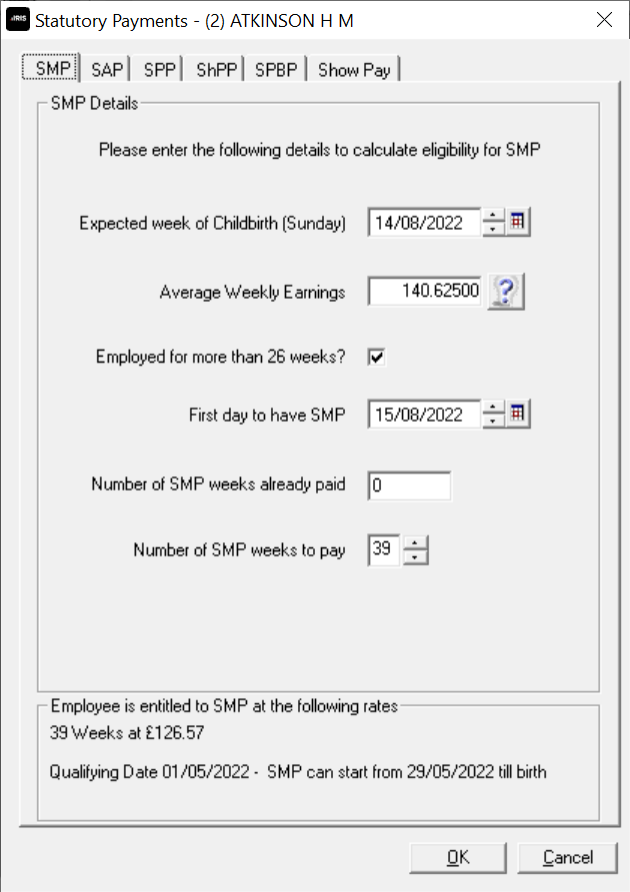Statutory maternity pay (SMP)
All the help you need for IRIS Payroll.
You can find more help and resources on the IRIS Payroll Help Hub.
Including: Payroll & HR legislation, Important dates and figures and My ePay Window.
Paying statutory maternity pay (SMP)
Before creating a Statutory Payment for an employee, make sure to configure the Payroll Calendar first.
Eligibility for Statutory Maternity Pay
-
Open the required company.
-
Go to the Employee menu.
-
Select Statutory Payments.
-
Select the required employee.
-
Select OK.
-
The SMP tab selects automatically.

Expected week of Childbirth (Sunday)
Enter the date of the Sunday of the start of the expected week of childbirth. If the date you enter is not a Sunday, the program will tell you so and then will give you the option to change.
Average gross pay
The employee’s average gross pay during the qualifying period is shown here. If you are starting the program mid-year, you can enter a figure to force eligibility, rather than entering a gross pay history, week by week.
You can select the Show Pay tab card for details of the relevant eight weeks earnings used in the calculation of the average gross pay.
Select the SMP tab card to return to the main SMP details or OK to finish the SMP section.
Employed for more than 26 weeks?
If this is not ticked the employee will not qualify for SMP. The program checks the employee’s start date and puts a tick automatically if the employee qualifies.
First day to have SMP
If the employee gives you a date they plan to start their maternity leave, enter it here. Otherwise enter the same date as for the expected week of childbirth.
You will not be reminded. Payments start when the Payroll Date is on or after the first day on which SMP is due.
Number of Weeks Already Paid
The main reason for this field is for companies starting to use the payroll software part way through an employee's maternity leave. You need to enter how many weeks have already been paid in order for the system to calculate the Number of Weeks SMP to pay.
Number of Weeks SMP to Pay
If the employee wishes to receive her full entitlement of SMP, leave this figure as it is. If they wish to come back to work before receiving their full entitlement, you may reduce the number of weeks accordingly.
You cannot increase them.
Employee is entitled to SMP at the following rates
The lower part of the window shows how much SMP has been calculated and when it can be taken. It also shows the date of the Sunday that begins the Qualifying Week.
Employee does not Qualify
If, at this stage, the employee still does not qualify for SMP when you think they ought to, it may be worth looking at their history of gross pay.
If you have not altered their Average gross pay and it reads 0.00 it means there is no record of gross pay in the qualifying weeks.
If you select the Show Pay tab card, you will see what gross pay there is on the employee’s records for the qualifying weeks.
If the qualifying weeks show zero pay when you know the employee really did earn money during that period it is probably because you have started to use the program comparatively recently.
In this case, select the SMP tab card and enter in the Average Gross Pay field the employee’s true average gross pay.
When you have finished entering details to establish qualification, select OK and, if SMP is due, the program will pay it at the proper time and in the proper amounts, automatically.
Payment of SMP
At payroll run time, you will not be reminded. SMP starts when the Payroll Date is on or after the first day on which SMP is due.
Each time SMP is paid, an entry is made in the employee’s diary for a whole week or multiple weeks and will be for the number of weeks being paid e.g. from the start date for seven, fourteen, twenty one, twenty eight or thirty five days. Other information written into the diary will be the date, type of payment, value and the pay period.
Payment of SMP to a Monthly Paid Employee
Everything to do with maternity pay is worked out in weeks. The payroll calendar is used to calculate the number of weeks SMP is to be paid in each pay period. The number of days from the first day to have SMP to the end of the work period (as defined by the calendar) will determine the number of weeks to pay. If the total number of days is less than seven the number of weeks paid will be zero. If the number of days is from seven to thirteen, one week will be paid, fourteen to twenty, two weeks etc.
